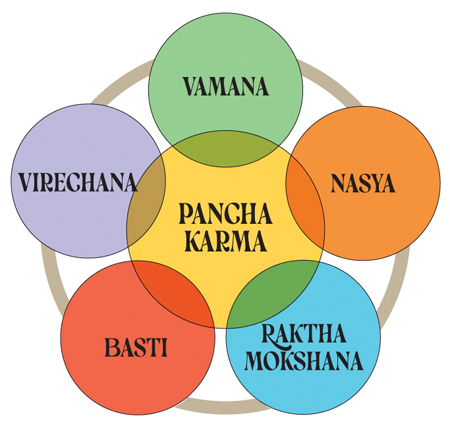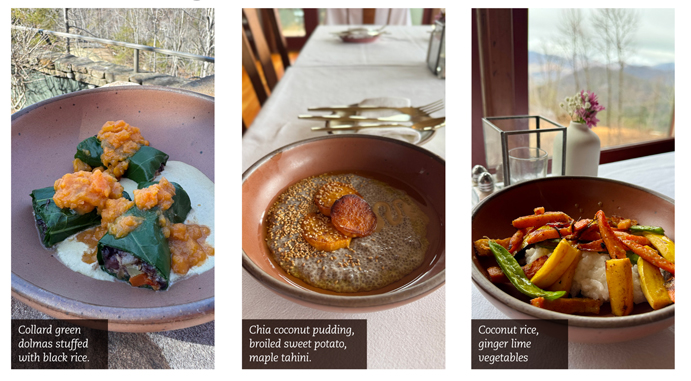Food & Dining: An Ayurvedic Detox: My Panchkarma Retreat Experience

What a week of sattvic meals, meditation, and self-care did for me and other attendees.
[Left] The author relaxing in the lounge of Ayurprana SoHum Mountain Healing Resort.
Even though I grew up in India, I had not heard of Panchakarma (PK) until recently. It is an ancient Ayurvedic process of cleansing, personalized to each individual based on their doshas, leaving them feeling deeply nourished, divinely fulfilled, and at home in their body and spirit.
Lately, I had been having digestion issues and my busy travel schedule and professional hazard as a food writer sure did not help! I was getting acupuncture, taking Chinese herbs, and watching what I ate. I had started seeing some alternative health care practitioners. That’s what got me interested in Ayurprana SoHum Mountain Healing Resort, a recently-opened luxury wellness retreat center in Asheville, North Carolina. The center offers week-long PK retreats that are primarily designed by Vasant Lad, the famous Ayurvedic practitioner. The promise of a one-week-long detox, where I would be in a controlled environment where I would eat according to a strict plan, seemed like the right push I needed.
Preparing for a Panchakarma retreat
I had not known that the dietary discipline needs to begin a few days before your arrival. In the week leading up to your retreat, you must give up gluten, sugar, alcohol, meat, dairy, and caffeine. In the final three days before you arrive at the center, you must follow a mono diet of fresh, homemade khichdi three times a day.
You also need to consume raw organic ghee (which Ayurprana sends you) by the tablespoons on an empty stomach. All these measures are designed to prepare your digestive system for the cleanse. During PK, the diet plan is wholly sattvic (meaning light, goodness, or purity in Sanskrit), invoking positivity and purity, benefiting the ojas (vigor) and your overall well-being.

Curated Ayurvedic meals
Once you arrive at the wellness center in Asheville, chef Sean Sigman and his team curate all the meals in-house. Sigman himself has been vegan since he was a teenager. After reading the Upanishads, he immersed himself in Ayurvedic cookbooks. Sigman worked at the Kushi Institute in Becket, MA, and learned about macrobiotics. He then went on to open a café in Florida and cooked at several vegan restaurants in Portland. Just prior to arriving at SoHum in July 2024, he had been heading the kitchen at the Art of Living Institute (AOL) in Boone, North Carolina.
Speaking of the meals during PK, Sigman says, “My food is always one that is healing, local, and seasonal. We don’t use any onions, garlic, and nightshade foods. The only protein we get is from yellow and green moong. And we use as many local and organic ingredients as possible.”
For the next seven days, I bonded with the other nine PK attendees over unfamiliar dishes made with familiar Indian spices. As the only person of Indian origin in the group, I could relate to many of the cooking styles and philosophies. My grandmother back in India also cooked seasonal and fresh vegetables in ghee. We always had a balanced meal of lentils, roti, rice, sabzi, yogurt, and small quantities of homemade dessert. She never stored leftovers and refused to buy a microwave. Milk, yogurt, and paneer arrived fresh daily. Meat was purchased once a week and was cooked and consumed on the same day. When I had a stomach upset, she fed me khichdi; and when I had a sore throat, she insisted on me having sooji ka halva made with lots of desi ghee.
Creative, colorful meals
Our welcome dinner on the first night was served in a cozy dining room against a warm fireplace in the wood cabin overlooking the Blue Ridge mountains. We had mashed pumpkin with fennel, pan-fried dhokla topped with curry leaves, mustard, seeds, and cumin seeds, and a side of greens and root vegetables. Along with the meal, we were given a “CCF” tea made with cumin, coriander, and fennel.
In the following days, we also had poha balls in carrot sambar (that reminded me of Jewish matzah ball soup), bright beet pulao with digestive spices, and other inventive recipes made from the same basic ingredients but served in different forms. We were always served pickled ginger on the side to help activate the digestive system. The meals were based on Ayurvedic principles using ingredients specific to Panchkarma: primarily rice lentils, ghee, and some vegetables.
Our breakfast consisted of khichdi, millet with cardamom, maple syrup, and orange blossom, and sometimes warm oats in coconut milk (the high fat helps with glycemic index). Everything was topped off with a generous spoon of ghee, an olation nutritive containing butyric acid that helps repopulate the gut bacteria and loosen toxins. It is considered to be a tri-doshic food meant for all three body types as differentiated by Ayurveda.
 Lunch was khichdi again, seasoned with mustard and cumin seeds, along with easy-to-digest vegetable soups and stews. Khichdi was always available between meals in case you got hungry. I must say I was never too full or too hungry, but I did crave certain things—like bread with my soup, biscuits with my tea, and something crunchy to bite into since all our food was semi-solid. The PK diet aims to satisfy all your senses so you don’t feel hungry but aren’t completely full either. In fact, Ayurveda encourages eating only when hungry and stopping when you are 75 percent full.
Lunch was khichdi again, seasoned with mustard and cumin seeds, along with easy-to-digest vegetable soups and stews. Khichdi was always available between meals in case you got hungry. I must say I was never too full or too hungry, but I did crave certain things—like bread with my soup, biscuits with my tea, and something crunchy to bite into since all our food was semi-solid. The PK diet aims to satisfy all your senses so you don’t feel hungry but aren’t completely full either. In fact, Ayurveda encourages eating only when hungry and stopping when you are 75 percent full.
Sneha Raichada, Dean of Education at the Ayurveda Institute and senior practitioner at SoHum, who helped create the PK menu, says, “During PK, we have a simplified, easy-to-digest menu that helps ignite agni (digestive fire), removes ama (toxins), and makes digestion easier. You can tell your ama is high when you get the feeling of indigestion, burping, bloating, gas, constipation, smelly sweat, or irregularity.”
Our mental and emotional state also influences our digestion, so we continued daily yoga, meditation, ayurvedic massage treatments, and sound healing, along with time for rest and introspection throughout the program. Staying still in one place was harder than I thought, as my mind often drifted to work and food. We all joked about ordering beer and pizza for delivery!
After PK, you can continue the process and heal at home by consuming foods that won't aggravate your specific dosha – Vata, Pitta, or Kapha. This means gradually reintroducing various foods, starting with roti, fruits, and nuts, and eventually dairy and meat.

The results: less stress, better skin, reduced cravings, and more
The results of PK vary from person to person. In my group, some felt lighter, while others experienced improved appetites. An elderly gentleman with Parkinson’s noted better mobility. A lady with skin issues noted her itching subsiding. Those dealing with stress appeared more relaxed. Overall, everyone seemed calmer, and their faces were glowing.
Raichada says, “Ayurveda has been around for thousands of years. If we follow the diet, lifestyle, and herbal recommendations, we can have stronger minds and bodies to deal with any ailment.”
I noticed my Vatta reduced, my food cravings declined, and my mind became still and relaxed. I did not have the urge to go check off my to-do list for the day or overindulge in snacks and meals.
Panchakarma at home
Not everyone can take the time away from home and work to go to a wellness resort, but the PK diet can be practiced at home just as easily by following the Ayurprana home cleanse online program that also comes with recipe guidelines. In his book, The Complete Book of Ayurvedic Home Remedies, Ayurvedic expert Vasant Lad recommends that you undertake this Panchakarma cleanse during a weeklong vacation so that you can escape your daily grind. Avoid this program if you are pregnant, weak, anemic, or debilitated.
Sucheta Rawal is an award-winning food and travel writer who has traveled to over 120 countries across seven continents, experiencing the world through her palate. She inspires people to travel more meaningfully and sustainably through her nonprofit, Go Eat Give, and her books, Beato Goes To. Find her on social @SuchetaRawal.
Enjoyed reading Khabar magazine? Subscribe to Khabar and get a full digital copy of this Indian-American community magazine.
blog comments powered by Disqus










